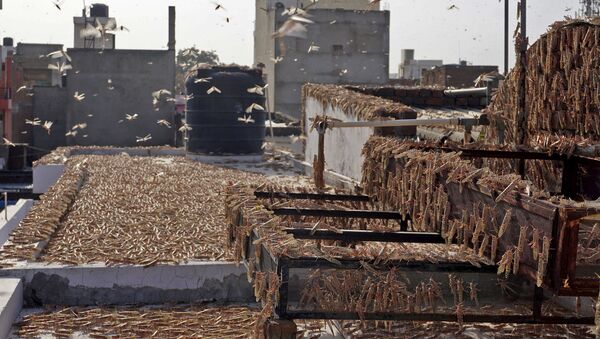The Indian government has been considering the widespread use of chemicals such as pesticides to control the locust invasion. Indian professor Rajinder Chaudhary, an advisor to Kudarti Kheti Abhiyan, an informal group that promotes self-reliant organic farming, tells Sputnik that environment-friendly methods of containing the infestation can be shown to be profitable.
The former economics professor has also written a letter to the agriculture ministers and agriculture secretaries of the government of India and Haryana expressing disappointment over the government's focus on chemical processes despite knowing the side-effects of the widespread aerial spraying of pesticides.
Sputnik: What environmental-friendly methods do you suggest to control the iocust population?
Rajinder Chaudhary: A few of the green and clean methods for locust control that I have gathered with the help of literature over last few days, can also be used to make money, rather than spending money. There are a few methods whose cost-benefit analysis I cannot make, but all others are free methods.
At night, locusts are stationary in a large group in open places. These do not travel or eat at night and therefore can be collected and used to 'mint money' as the insect can be used to prepare nutritious poultry feed. These are methods for scientist to work on. Locusts are a rich source of protein and so it becomes a nutritious poultry feed. One person can collect up to 10 quintals of locusts in a night.
Locusts can also be controlled by spraying with anything that makes the vegetative matter inedible for the crop-munching insect. The inedible layer of sand-water sprayed on crops to make them inedible can easily be removed from the crops using plain water once the threat is over.
This non-chemical method that I refer to has been recommended by an Indian farmer on whom this very government has conferred the 'Padma Shri' [fourth highest civilian award] for controlling locusts without serious side effects. Yet, they [the government] are not even trying the method that the farmer suggested and popularlized.
Another method to eradicate the pest within 24 hours is through the use of a concoction of linseed oil, edible soda/sodium bicarbonate and extracts of garlic, cumin and orange. The mixture is then sprayed in field and has no side effects on crops.
Sputnik: What is preventing the government from deploying these green methods?
Rajinder Chaudhary: The government is following the trodden path. Other alternatives are developing and government must explore them. Our bureaucracy in the agriculture sector, such as in universities, has been trained in chemical methods only. Traditionally, agriculture has been only chemical based and they have been doing it for 50-60 years now.
Another reason is that there appear to be no profits to be made from the green methods of locust control. Most are biological/non-chemical and self-reliant methods. If it doesn't involve a cost, it doesn't interest a bureaucrat.
Sputnik: Chemical processes have been termed very effective in dealing with locusts. Experts have suggested that the effect of chemicals will be lessened with the onset of monsoon. Your comment?
Rajinder Chaudhary: With the onset of monsoon, these chemicals will be washed away into our water sources, you must realise that. I would term this much more dangerous than the locust invasion.
While the locust menace cannot be ignored, what must also be ensured is that the eradication methods do not pollute air, water, environment and the food chain.
Sputnik: How can the Indian government be better prepared to deal with this kind of situation in the future?
Rajinder Chaudhary: The first thing they have to do is study the efficiency of the methods they have been using all along and compare it with alternative methods that should be fully explored. Various agriculture experts have pointed out that research on green locust control methods in the last few years has been totally neglected. As we have not recently grappling with such attacks, so they were not researching these issues.




